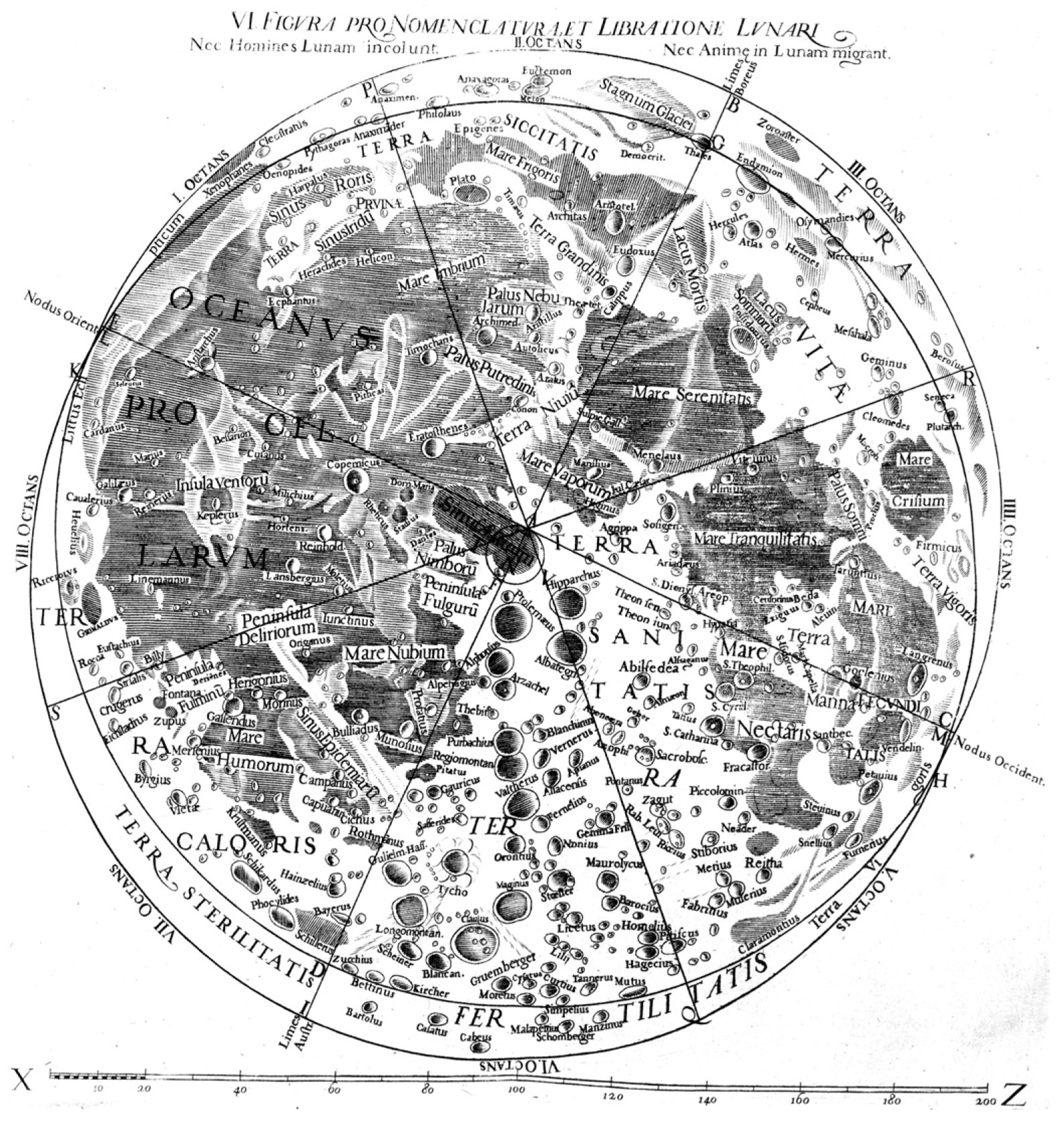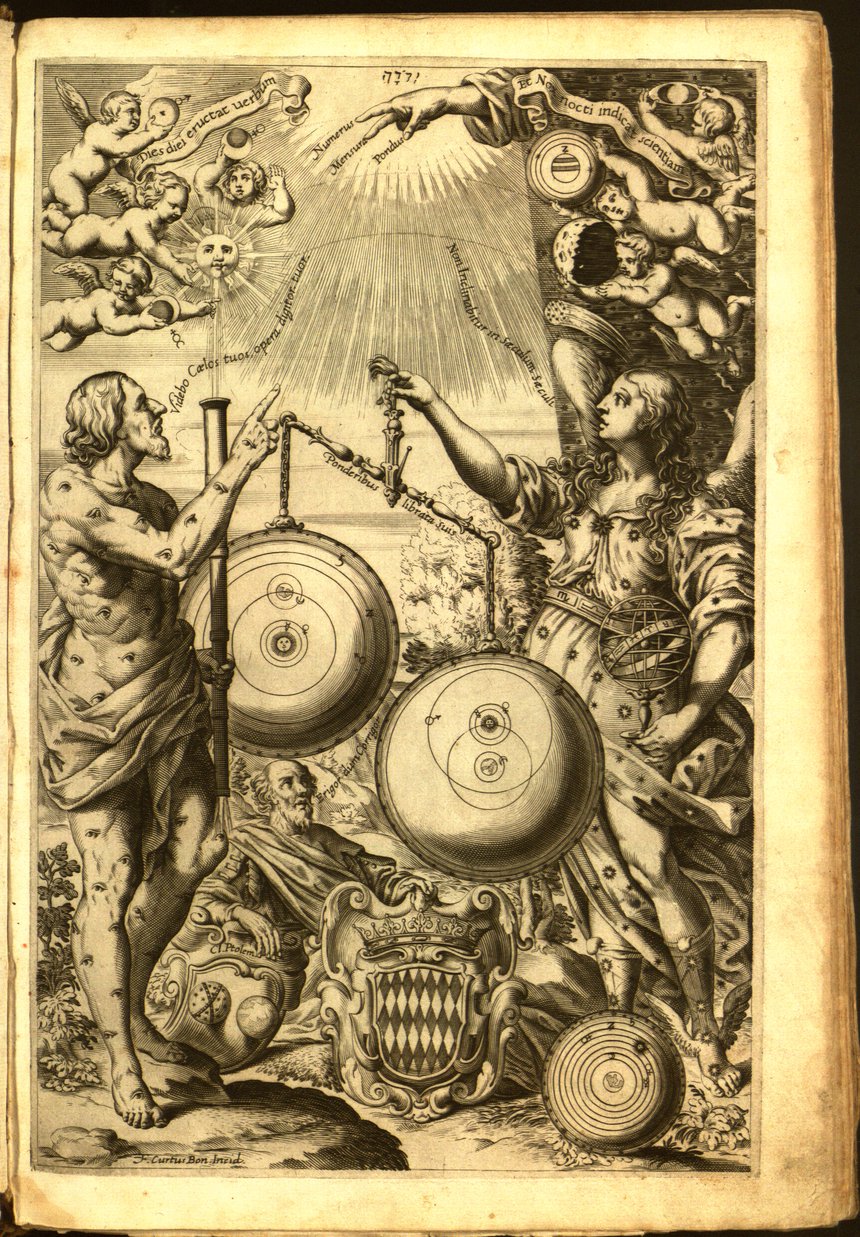All, or almost all, enthusiasts know that the names of the craters and lunar formations we use today mostly date back to an Italian astronomer, the Jesuit Giovanni Battista Riccioli (1598-1671) who distributed the names of scientists, philosophers on our satellite and astronomers who had somehow dealt with the Moon in their research.
Criteria that Riccioli used to place the names are less well known, and partly explained by himself in his major work, the Almagestum novum, from which the map below is taken. Riccioli divided the Moon into eight segments, or rather octants, of which the first is located approximately at 11 o'clock and the others follow clockwise, respecting an approximately chronological order and basically grouping the names by disciplines (philosophers with philosophers, astronomers with astronomers, etc.). The Moon apparently does not rotate, which explains why such a system works.
Thus, ancient physicists and astronomers find their place in the first two octants. Eratosthenes, who measured the Earth three centuries before Christ, is located in the southern portion of the first octant, while Plato is placed in the second not far from his student Aristotle. In the third and fourth octants the personalities of ancient Rome begin to appear. Here we find Julius Caesar, and near him the Alexandrian astronomer Sosigenes on whose instructions the dictator had reformed the calendar. Also in the 4th octant there is an interesting anachronism, Langrenus (Van Langren). What is a contemporary of Riccioli doing here?
The answer lies in the fact that Riccioli's work did not arise from nothing but was mainly based on two other lunar cartography works, the first by Van Langren, and the other by Hevelius, shortly preceding his Almagestum. Out of respect for the former, after having killed his nomenclature, Riccioli made an exception and placed Langrenus exactly in the crater that his Flemish colleague dedicated to himself. Furthermore, the idea of calling the wide dark plains "seas" is also by Van Langres, and was kept by Riccioli.
In the sixth quadrant the great Arab astronomers are remembered, in particular here we find Arzachel (Al-Zarqali) and Albategnius (Al-Battani) together with names of contemporaries such as Clavius, Longomontanus, Moretus, etc.

Riccioli original map (1651)
A clarification is appropriate here. Riccioli incorporates into his system the popular belief according to which the waxing Moon (therefore with the eastern part illuminated, on the right on the map) brings good weather, and the opposite in the case of a waning Moon. Then, he named the eastern (Sea of Serenity, Bay of Rainbows...) and western (Ocean of Storms, Sea of Clouds, etc.) formations in agreement. The eighth and final octant is right here, in the stormiest area of the Moon, and here are placed the astronomers guilty of believing in the heliocentric system: condemned to wander "like islands floating in dangerous waters". Fair punishment, according to Riccioli, for those who had taken away from the Earth its place at the center of the Universe, assigned to it in the Holy Bible.
The undisputed protagonist of this octant is just that Copernicus, whose system was forcefully rejected by Father Riccioli, although some say that this is a somewhat showy force. Observers and imagers well know this large crater, which with its rays of ejecta seems to dominate an immense area of the Moon. Aristarchus, the Greek astronomer who with an unprecedented intellectual jump dared to remove the Earth from the center of the world is here, but is rightly placed on the edge between the 1st and 8th octants. One of the brightest craters on the moon is dedicated to him, sometimes even dazzling, and it is likely that Riccioli also considered this feature (the albedo) when choosing the names. In fact, he does not say everything, and it is not certain that he believes everything he says. Galileo's recent process, and the dress he wore, recommended caution.
The crater dedicated to Tycho Brahe could be convincing evidence. Large, with an enormous brilliant ray, he seems to want to enlighten all other men by showing them the only true system: the Tychonic one, in fact, a mixture of the heliocentric and geocentric system in which Riccioli himself believed. In fact, the frontispiece of the Almagest (a masterpiece of baroque illustration which for its beauty alone deserves a separate chapter), shows the virgin Astraea while comparing the systems of Tycho and Copernicus. The scale, of course, tips in favor of the former.
Riccioli also placed himself in the last octant, and although his crater is of considerable size (150 km) it is located in the full libration zone, making it inconspicuous.
A crater is dedicated to Kepler in 8th octant, not huge in size but nevertheless notable, as it is found, almost isolated, above a light area which highlights it greatly. A scholar, Whitaker, noted that this crater is located along the continuation of one of Tycho's rays, and that its ray is connected with those of Copernicus and Aristarchus, almost as if wanting to link the three names for eternity. Are these mere hypotheses that please modern biographers, or was Riccioli more Copernican than he wanted us to believe? It is a fascinating idea that finds support in its own nomenclature, in which, perhaps intentionally, some connections are only suggested or are unclear, and leave room for a series of suppositions. Unlike Schiaparelli in choosing his classical names for Mars more than two centuries later, Riccioli certainly did not believe the Moon was inhabited. The familiar terms of terrestrial geography that he used, such as mountains, Apennines, seas, lakes, are nothing more than poetic forms, as demonstrated by the Latin inscription at the head of the map:
Nec homines Lunam incolunt, nec Animae in Lunam migrant

Almagestum Novum frontispiece
On the left, the shepherd Argus observes the Sun with one of his one hundred eyes, using the newly invented telescope. On the other side, Urania (or the maiden Astraea) weighs the two systems of Copernicus and Tycho, while Ptolemy lies on the ground saying “erigor dum corrigor” (“I rise even if I am corrected”). At the top right, the cherubs show the main astronomical discoveries of those years: the bands of Jupiter, the rings of Saturn, the lunar craters.